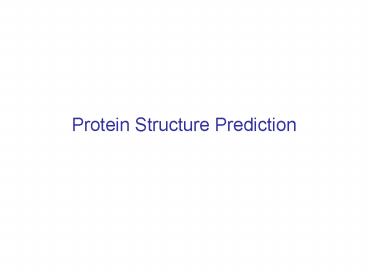Protein Structure Prediction - PowerPoint PPT Presentation
1 / 25
Title:
Protein Structure Prediction
Description:
Defined by its position (x,y,z), its shape (usually a ball) ... Eaton, et al, NIH. PPA: Gruebele, et al, UIUC. BBAW. http://pande.stanford.edu/ Homology Modeling ... – PowerPoint PPT presentation
Number of Views:30
Avg rating:3.0/5.0
Title: Protein Structure Prediction
1
Protein Structure Prediction
2
The Press
3
Energetics of protein structure
4
What is an atom?
- Classical mechanics a solid object
- Defined by its position (x,y,z), its shape
(usually a ball) and its mass - May carry an electric charge (positive or
negative), usually partial (less than an electron)
5
Atomic interactions
Non-bonded pair
Torsion angles Are 4-body
Angles Are 3-body
Bonds Are 2-body
6
Forces between atoms
- Strong bonded interactions
b
All chemical bonds
q
Angle between chemical bonds
Preferred conformations for Torsion angles -
w angle of the main chain - c angles of the
sidechains (aromatic, )
f
7
Forces between atoms vdW interactions
r
1/r12
Lennard-Jones potential
Rij
1/r6
8
Forces between atoms Electrostatics interactions
r
Coulomb potential
qi
qj
9
Protein Structure Prediction
- One popular model for protein folding assumes a
sequence of events - Hydrophobic collapse
- Local interactions stabilize secondary structures
- Secondary structures interact to form motifs
- Motifs aggregate to form tertiary structure
10
Protein Structure Prediction
A physics-based approach - find conformation
of protein corresponding to a thermodynamics
minimum (free energy minimum) - cannot minimize
internal energy alone! Needs to include
solvent - simulate foldinga very long
process! Folding time are in the ms to second
time range Folding simulations at best run 1 ns
in one day
11
What is a molecular dynamics simulation?
- Simulation that shows how the atoms in the system
move with time - Typically on the nanosecond timescale
- Atoms are treated like hard balls, and their
motions are described by Newtons laws.
12
Why MD simulations?
- Link physics, chemistry and biology
- Model phenomena that cannot be observed
experimentally - Understand protein folding
13
Characteristic protein motions
Periodic (harmonic)
Random (stochastic)
14
The Ergodic Hypothesis
- Time averages Ensemble Averages
15
The Folding _at_ Home initiative
(Vijay Pande, Stanford University)
http//folding.stanford.edu/
16
The Folding _at_ Home initiative
17
Folding _at_ Home Results
Experiments villin Raleigh, et al, SUNY,
Stony Brook BBAW Gruebele, et al, UIUC beta
hairpin Eaton, et al, NIH alpha helix Eaton,
et al, NIH PPA Gruebele, et al, UIUC
100000
villin
BBAW
10000
beta hairpin
1000
Predicted folding time (nanoseconds)
100
alpha helix
10
PPA
1
1
10
100
1000
10000
100000
experimental measurement (nanoseconds)
http//pande.stanford.edu/
18
Homology Modeling
19
Structural Genomics project
- Aim to solve the structure of all proteins this
is too much work experimentally! - Solve enough structures so that the remaining
structures can be inferred from those
experimental structures - The number of experimental structures needed
depend on our abilities to generate a model.
20
Structural Genomics
Proteins with known structures
Unknown proteins
21
Homology Modeling How it works
- Find template
- Align target sequence
- with template
- Generate model
- - add loops
- - add sidechains
- Refine model
22
Homology Modeling Practical guide
Submit target sequence to automatic servers -
Fully automatic - 3D-Jigsaw
http//www.bmm.icnet.uk/servers/3djigsaw/ -
EsyPred3D http//www.fundp.ac.be/urbm/bioinfo/esy
pred/ - SwissModel http//swissmodel.expasy.or
g//SWISS-MODEL.html - Fold recognition -
PHYRE http//www.sbg.bio.ic.ac.uk/phyre/ -
Useful sites - Meta server
http//bioinfo.pl/Meta - PredictProtein
http//cubic.bioc.columbia.edu/predictprotein/
23
The CASP experiment
- CASP Critical Assessment of Structure Prediction
- Started in 1994, based on an idea from John Moult
(Moult, Pederson, Judson, Fidelis, Proteins,
232-5 (1995)) - First run in 1994 now runs regularly every
second year (CASP6 was held last december)
24
The CASP experiment how it works
1) Sequences of target proteins are made
available to CASP participants in June-July of a
CASP year - the structure of the target protein
is know, but not yet released in the PDB, or
even accessible 2) CASP participants have
between 2 weeks and 2 months over the summer of
a CASP year to generate up to 5 models for each
of the target they are interested in. 3) Model
structures are assessed against experimental
structure 4) CASP participants meet in December
to discuss results
25
CASP Statistics































